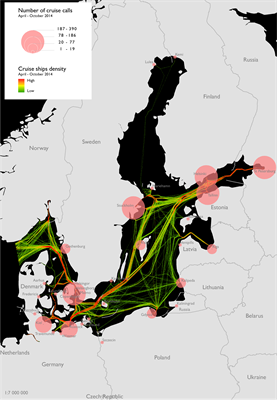Passenger ship sewage discharges into the Baltic Sea will be banned

A major milestone reached through HELCOM cooperation
The International Maritime Organization (IMO) agreed this week that the Baltic Sea special area for sewage discharges from passenger ships under Annex IV or the MARPOL Convention will take effect by latest 2021 for IMO registered passenger vessels. However, in certain cases of direct passages between St. Petersburg area and the North Sea there is a two-year extension to the deadline, until 2023.
The decision means that by 2021 all IMO registered passenger vessels sailing in the Baltic Sea, as the first region in the world, must discharge all sewage at port reception facilities (PRFs), or treat it with an on-board treatment plant certified to meet stringent special area requirements. For new ships built on or later than 2019, these requirements will apply earlier.
The significant outcome concludes the long HELCOM process aiming to limit sewage discharges in the Baltic Sea from passenger vessels, as the emissions have negative impact on the marine environment.
The decision was made during the meeting of the IMO Marine Environment Protection Committee (MEPC) ending today in London.
The proposal to designate the Baltic Sea as a special area for sewage within MARPOL Annex IV was developed by the HELCOM Maritime Working Group, which is made up of maritime administrations of the Baltic Sea coastal countries and the EU. This proposal was submitted to IMO MEPC by the coastal countries in 2010, following a decision by the 2007 HELCOM Ministerial Meeting in Cracow, Poland.
Based on the submission the Baltic Sea was designated by IMO as a special area for sewage in 2011. However, according to the IMO decision this status would only take effect once the coastal countries informed IMO that adequate Port Reception Facilities are available in the region.
By the IMO meeting this week, all Baltic coastal countries had sent confirmation of adequate reception facilities in Baltic ports, as a result of substantial work on port reception facilities for sewage and their use in the Baltic Sea area by national administrations, ports and the passenger ship industry.
In order to document overall progress on sewage PRFs and their use in the region during recent years, an overview document was published by HELCOM in early 2015.
Upcoming events where related issues will be discussed include a joint session by HELCOM and CLIA on 18 May during the EU Maritime Day 2016 in Turku, Finland, and the International Workshop on Port Reception Facilities for the Baltic Sea as Special Area according to MARPOL Annex IV by Germany and BPO on 30 June - 1 July in Kiel, Germany.
Background
The momentum to submit a proposal to designate the Baltic Sea as a sewage special area comes from the fact that standards for, and implementation of, sewage treatment on the shore in the Baltic Sea region have been tightened considerably during the last decades—with stringent requirements applied today not only to cities but also to smaller municipalities and in some countries even leisure boats. The Nitrogen and Phosphorus contained in ship sewage aggravate the eutrophication of the Baltic Sea.
From the perspective of the Baltic Sea, this week’s decision in London is a major milestone in more than 35 years of work to improve facilities and reduce sewage emissions from ships in the region.
Already at the first meeting of the Helsinki Commission, or HELCOM, in 1980, the coastal countries adopted regional Recommendations targeting sewage from passenger ships, concerning both port reception as well as on-board treatment plants.[1]
The process has seen several rounds of negotiations and milestones as part of HELCOM Ministerial Meetings, such as the Baltic Sea PRF strategy of 1996 and the 2010 list of priority ports for sewage PRF upgrades. Very importantly, since Convention revision in 1992 these negotiations have included in addition to national administrations also the shipping industry as well as ports.
Note for editors
HELCOM Maritime Working Group identifies and promotes actions to limit sea-based pollution and finds ways for safer navigation. Established in 1975, the group also deals with the harmonized implementation and enforcement of international shipping regulations.
The Maritime group includes the HELCOM-OSPAR Task Group on Ballast Water Management (regional dimensions of implementing the IMO Ballast Water Management Convention), Expert Group on Safety of Navigation, Working Group for Mutual Exchange and Deliveries of Automatic Identification System (AIS) data, and HELCOM Cooperation Platform on Port Reception Facilities (PRF).
HELCOM is an intergovernmental organization made up of the nine Baltic Sea coastal countries and the European Union. Founded in 1974, its primary aims as a governing body are to protect the marine environment of the Baltic Sea from all sources of pollution, as well as to ensure safe maritime navigation. The official name of HELCOM is the Baltic Marine Environment Protection Commission; it is the governing body of the Helsinki Convention.
* * *
For more information, please contact:
Anna Petersson
Chair of HELCOM Maritime group
Head of Environment Section
Swedish Transport Agency
Tel: +46 10 4953 249
E-mail: anna.petersson(at)transportstyrelsen.se
Hermanni Backer
Professional Secretary for Maritime, Response and Fish groups
HELCOM
Tel: +358 46 8509199
E-mail: hermanni.backer(at)helcom.fi
[1] See e.g. HELCOM Recommendation 1/5 (adopted 5 May 1980): “Recommendation concerning the application by the Baltic Sea states of guidelines for type testing and approval of sewage treatment systems”.



